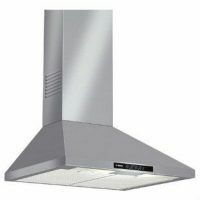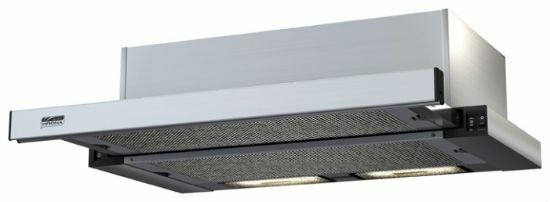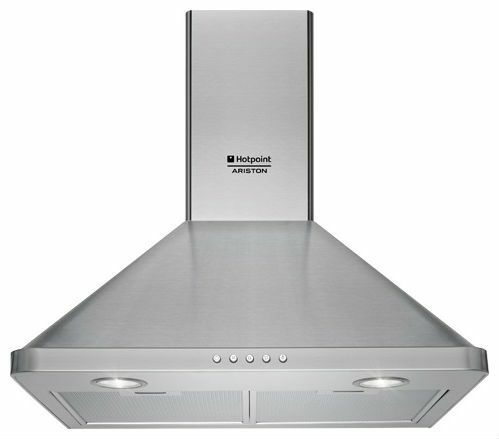
An extractor installed in the kitchen is a device that is designed to clean air of unpleasant odors and combustion products;To choose the right hood, it is necessary to take into account a number of important features of this device. About the types, basic characteristics, useful additional possibilities of hoods, we will describe below.
- Types of hoods
- Suspension hood
- Built-in hood
- Chimney hood
- Suggestions for selecting hoods
- Hood dimensions
- Hull material: plastic, metal or wood?
- Color of housing
- Diameter of air duct
- Number of motors
- Number of speeds
- Operating modes
- Power consumption and performance
- Maximum noise level
- Filter: grease or coal?
- Type of lighting, number and power of lamps
- Type and controls
- Useful functions of hoods
- Display and remote control
- Timer
- Interval operation and intensive mode
- Automatic activation
- Lighting adjustment and focusing
- Filter contamination indicator
- Anti-return valve
- Design "Domino"
- Hoods manufacturers
Types of hoods
The hood classification is based on the type of construction of the device, as well as the method and location of its installation. On this basis, all the hoods are divided into:
- pendant;
- recessed;
- fireplace.
Suspension hood

Features small overall dimensions, flat shape, small working area. Installed such an extract under the kitchen cabinet.
Advantages:
- compactness;
- low cost;
- easy installation;
- possibility of installation in small-sized kitchen areas.
Disadvantages:
- low performance;
- impossibility of use in actively operated premises.
Built-in hood

It works, as a rule, in flow mode, therefore it requires special piping. Thanks to the design features, it fits harmoniously into the interior of the room, only the fence part of the device remains in sight. Can be built in both kitchen cabinets and under the countertops.
Advantages:
- aesthetics;
- efficiency;
- high performance.
Disadvantages:
- installation complexity;
- is often a high cost.
Fireplace hood

Due to the peculiarities of its shape, it received a second name - the dome. The design of such an extract is similar to the design of the exhaust system of fireplaces. Air enters the dome-shaped body, and then ventes through the duct. Often it is part of the interior design, looks bright and expensive. Fireplace hood can be wall, island and corner - depending on the location and installation. The fireplace hood can also be inclined - this kind of ergonomics and low noise level.
Advantages:
- high efficiency;
- effect;
- the possibility of selecting the hood for a room, decorated in any style.
Disadvantages:
- high cost;
- the need for a number of additional work before installing the hood.
Tips for selecting the
hood to the table of contents ^Overall dimensions of the hood
The height, depth and width of the hood depends on its type. If in the interior of your kitchen there is no special place for the hood, then only a hanging option is suitable for you. Dimensions of fireplace and built-in hood are selected individually, based on the size of other items in the kitchen.
to contents ^Case material: plastic, metal or wood?
The cheapest options for hoods are made of plastic. It is durable, durable, unpretentious in care.
Hoods with a metal casing have, as a rule, quite high cost, they look more impressive, but the performance characteristics of plastic do not exceed.
Hoods with a wooden hull are the most expensive option, they are mainly made to order. In some cases, the hoods with a wooden box are additionally decorated with glass elements( from the contrasting in texture and color of the material, as a rule, the fringing or the hood panel is made).
to contents ^Body color
When selecting the hood, consider that it must harmoniously fit in the interior, and match it in style and color. Manufacturers offer a wide range of color and shade solutions.
to contents ^Diameter of air duct
The diameter of the duct can be from 100 to 200 millimeters. For proper installation of the hood, the size of the inlet of the ventilation shaft and the diameter of the hood must be taken into account. Some manufacturers include an adapter in the scope of delivery, so that installation is easy.
to contents ^Number of
engines The vast majority of the hoods are equipped with one motor, but if you are looking for a hood more powerful, you can pick up a model with two engines. But keep in mind that such modifications have a higher cost, consume more electricity and produce more noise.
to contents ^Number of speeds
If you have selected a multi-speed hood model, you can select the most appropriate mode of operation depending on the use of the room. Manufacturers offer hoods that work both at one and almost twenty speeds. Five-seven speeds is enough.
to contents ^Operating modes
Hoods can have two operating modes:
- circulation mode;
- air bleed mode.
When operating in circulation mode, the air passing through the exhaust filters is cleaned and returned to the room. The use of this mode is the only way out, if there is no possibility to remove contaminated air outside the premises. It is convenient to use this mode also in the cold season, when it is unprofitable to let the warm air out.
When the extractor is operated in the exhaust air mode, the polluted air is exhausted through the ventilation system outside the room. The efficiency of the hood when operating in this mode is significantly increased.
Inexpensive models of hoods work only in one mode. More expensive can work in both air exhaust and circulation mode.
to contents ^Power consumption and performance
The maximum output power directly affects its performance, as well as the cost of the device. In modern extracts, the value of the maximum power parameter can reach 25-500 watts.
Performance refers to the throughput of the hood, that is, the maximum volume of air that the device can pass through itself in one hour when operating in air-exhaust mode. The performance depends on the performance of the device. Productivity can be in modern extracts from 90 to 2500 cubic meters per hour. The optimum air exchange is calculated based on the volume of the kitchen.
to contents ^Maximum noise level
The maximum noise level of the hood depends on many parameters - the number of motors, power, device design. Manufacturers offer models of hoods with a maximum value of this parameter from 30 to 75 dB.If excessive noise to you to anything, choose the models with a noise level of no more than 40-50 dB.
to the table of contents ^Filter: fat or coal?
The efficiency of the hood is also influenced by the type of filter installed. There are models equipped with only one type of filter( fat), as well as models with two filters( fat and coal).The latter option is most preferable. The grease filter is a coarse filter made of metal that protects the device from fat particles that get into the air when cooking. The carbon filter is a fine filter, which is designed to catch unpleasant odors. When working together they really clean air qualitatively.
to contents ^Type of lighting, number and power of lamps
The vast majority of modern hoods are equipped with built-in lamps that illuminate the workspace of the plate. Variants of used lamps can be several:
- incandescent lamps( the most energy-consuming, but least expensive option);
- fluorescent lamps( have high light output, are economical, create cold diffuse light);
- halogen lamps( differ in small size, large light output, smooth bright light);
- neon lamps( shine orange-red light, durable);
- LED lamps( give a soft pleasant light, are the most economical).
Lamps can have different power. The smaller the power of the lamps, the more they will be needed for high-quality lighting.
to contents ^Type and controls
The exhaust control can be mechanical and electronic. Models with mechanical control are inexpensive, easy to operate. Switching speeds, switching modes can be done by pressing the buttons or moving the sliders.
As for models with electronic control, they are more perfect, because they have advanced capabilities. For example - automatic programs. Many of them are equipped with a display. Electronic control can be touch or push-button. The cost of hoods with electronic control is an order of magnitude higher.
to contents ^Useful functions of
hoods to contents ^Display and remote control
The display is equipped with models with electronic control, it is installed on the front panel of the hood. The display shows information about the parameters and operating modes of the device. For convenient control of the hood, the unit can be supplied with a remote control.
to contents ^Timer
The timer set for a certain time will turn off the hood or move it to a different mode of operation.
to contents ^Interval operation and intensive mode
The interval operation mode assumes the periodic activation of the hood, its operation for a certain time and shutdown. Allows you to remove unpleasant odors from the premises during the absence of the owners.
Intensive mode is designed for quick and high quality removal of unpleasant odors. For a certain time it works with increased intensity, then automatically switching to the previously set speed.
to contents ^Automatic activation of
Some models of hoods have a built-in humidity and temperature sensor, which, if exceeded, activates the extraction function.
to contents ^Adjustment and focusing of lighting
In expensive models of hoods it is possible to adjust the brightness of illumination of built-in lamps. Lighting can also focus - to direct to a certain part of the surface or, conversely, to dissipate.
to contents ^Indicator of filter contamination
The indicator can be mechanical - filters are marked with special symbols that disappear or disappear at the end of filter life or electronically - a special indication appears on the display indicating the need to replace the filter.
to contents ^Anti-return valve
Anti-return valve is installed in the air duct. Its main purpose is not to allow air from the duct to penetrate the room through the hood when the device is turned off.
to contents ^Design "Domino"
Design "Domino" assumes a special way of embedding the hood. It is installed in the exhaust unit of the countertop, located next to the cooker. When there is a need in the hood, it extends upwards and is used for the intended purpose, after which it is just as easily pushed back.
to contents ^Manufacturers of hoods
Specialists recommend customers to stop their choice of products from such manufacturers:
- Bosch;
- Gorenje;
- Samsung;
- Siemens;
- Hansa;
- Hotpoint-Ariston.
Take enough time to choose the hood - the most important device in absolutely any kitchen, and then the comfort of staying in this room will be provided to you.
